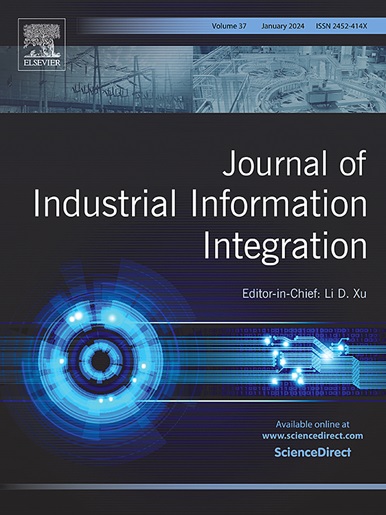基于RBC的协同云和边缘计算方法,用于联合通信和计算资源分配
IF 10.4
1区 计算机科学
Q1 COMPUTER SCIENCE, INTERDISCIPLINARY APPLICATIONS
引用次数: 0
摘要
随着云计算和边缘计算在工业物联网(IIoT)和人工智能驱动的智能制造系统中的广泛应用,在通信和计算资源受限的情况下,提高云边缘协作的效率已成为一个突出的研究热点。为了解决智能制造系统中的联合通信和计算资源分配问题,提出了基于协同服务中角色协作(Role-Based Collaboration, RBC)的GRALB模型,对终端用户任务在边缘节点和云之间的卸载策略进行综合管理。首先,基于云边缘协作的物理场景,共同建模端到端时延和能耗。在此基础上,对基于E-CARGO的GRA模型进行了扩展,提出了具有负载均衡的GRALB模型,将原有的联合通信和计算资源分配问题形式化地建模为等效协同服务模型,并证明了算法的收敛性。最后,我们设计了一个x-ILP解决方案来支持所提出模型的验证和集成应用。仿真结果进一步证实了我们的理论分析,并表明所提出的协同云和边缘计算解决方案显着提高了整体系统性能。本文章由计算机程序翻译,如有差异,请以英文原文为准。
Method towards collaborative cloud and edge computing via RBC for joint communication and computation resource allocation
With the extensive adoption of cloud and edge computing in intelligent manufacturing systems driven by the Industrial Internet of Things (IIoT) and Artificial Intelligence, enhancing the efficiency of cloud-edge collaboration under constrained communication and computational resources has emerged as a prominent research focus. We develop the GRALB model, which is based on Role-Based Collaboration (RBC) in cooperative services, to comprehensively manage the offloading strategy of terminal user tasks between edge nodes and the cloud to solve the joint communication and computing resource allocation problem in intelligent manufacturing systems. First, we jointly model the end-to-end latency and energy consumption based on the physical scenario of cloud-edge collaboration. Then, we extend the GRA model based on E-CARGO and propose the GRALB model with load balancing, which formally models the original joint communication and computing resource allocation problem as an equivalent cooperative service model and provides a proof of algorithm convergence. Finally, we design an x-ILP solution to support the verification and integrated application of the proposed model. Simulation results further confirm our theoretical analysis and show that the proposed collaborative cloud and edge computing solution significantly improves the overall system performance.
求助全文
通过发布文献求助,成功后即可免费获取论文全文。
去求助
来源期刊

Journal of Industrial Information Integration
Decision Sciences-Information Systems and Management
CiteScore
22.30
自引率
13.40%
发文量
100
期刊介绍:
The Journal of Industrial Information Integration focuses on the industry's transition towards industrial integration and informatization, covering not only hardware and software but also information integration. It serves as a platform for promoting advances in industrial information integration, addressing challenges, issues, and solutions in an interdisciplinary forum for researchers, practitioners, and policy makers.
The Journal of Industrial Information Integration welcomes papers on foundational, technical, and practical aspects of industrial information integration, emphasizing the complex and cross-disciplinary topics that arise in industrial integration. Techniques from mathematical science, computer science, computer engineering, electrical and electronic engineering, manufacturing engineering, and engineering management are crucial in this context.
 求助内容:
求助内容: 应助结果提醒方式:
应助结果提醒方式:


